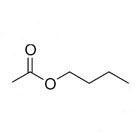What is N-Butyl Acetate?
Normal butyl acetate (also known as n-butyl acetate, butyl acetate, butyl ethanoate, 123-86-4) is a clear, colourless ester with a molecular formula of C6H12O2. It is found in various fruits, red apples in particular, and employs characteristic flavours with a sweet banana smell. This organic compound has a variety of uses including as a food flavouring, as a solvent in the process of lacquer production, in polishes, inks, adhesives and occasionally as a high-boiling solvent.

Technical Properties
Chemical and physical properties of Butyl Acetate:
Molecular Formula: C6H12O2 / CH3COO(CH2)3CH3
Synonyms: n-butyl acetate, butyl acetate, butyl ethanoate, butyl ester
Molecular Formula: C6H12O2 / CH3COO(CH2)3CH3
Molecular Mass: 116.160 g/mol-1
Exact Mass: 116.08373 g/mol
Flashpoint: 72 °F / 22 °C
Boiling Point: 259.7 °F / 126.1 °C
Melting Point: −108 °F / −78 °C
Vapour Pressure: 10 mm Hg at 68 ° F
Water Solubility: 0.68 g/100 mL (20 °C)
Density: 0.8825 g/cm3 (20 °C)
Log P: 1.82
Butyl Acetate is highly flammable and highly miscible with many organic solvents including alcohols, esters and glycols. It is only slightly miscible in water.
How is it produced?
The most common method of manufacturing butyl acetate commercially is by the esterification of butanol and acetic acid which are then heated by a catalyst such as sulfuric acid. If an isomer of butanol is used instead, you will form an isomer of butyl acetate.
How is it handled, stored and distributed?
Butyl acetate has many different hazard warnings and properties; therefore, great precaution and care must be taken during the handling and distribution process.
Hazards and toxicity
Butyl acetate is classed as highly flammable both with fire (an NFPA rating of 3) and air and water reactions. It can be easily ignited by high temperatures and flames. Its vapours are also heavy and will travel to an ignition source and form explosive mixtures with the air.
It also has an NFPA health rating of 2. Avoid inhaling as this will cause headaches, drowsiness, irritation of the mouth, nose eyes, and nausea. The use of PPE equipment is required for both eyes and skin as this will help to avoid prolonged exposure of butyl acetate as it can cause dryness.
Storage and distribution
A chemical trader would have a bulk petrochemical storage facility to regulate this product. Storage is normally in a cool, dry and well ventilated facility away from other strong oxidising agents and acids. Normal butyl acetate should be kept out of direct sunlight, heat and open flames and stored in drummed containers which are tightly closed such as isotanks made of stainless steel, aluminium or carbon steel. Containers that are opened must be closed and kept grounded to prevent spillage. It is important to ensure that entry of butyl acetate into sewers, basements or waterways is prevented and that vapour is suppressed where appropriate to reduce spread and risk.
A bulk solvent exporter would normally distribute this solvent in bulk vessels or tank trucks. For transportation purposes, normal butyl acetate is classed as a flammable liquid. A full bulk chemical distributor would export the solvent throughout regions such as the UK, Europe, Africa and America. This product is a packing group 3.
What is N-Butyl Acetate used for?
Butyl acetate has a variety of industry and consumer uses with its main end-user markets including paints/lacquers, coatings, cosmetics, leather, cleaning and the pharmaceutical industries.
Industry uses
Normal butyl acetate’s most common industry use is in the production of lacquers and paints (due to its low volatility) as a solvent. Additionally, it has uses in the manufacturing of artificial leather, plastics adhesives and hardened coatings and topcoats.
It is commonly used in the pharmaceutical industry as a solvent or an extraction agent for processing oils and coatings. Other industry uses include lubricants, intermediaries, fruit flouring and various additives.
Consumer uses
Butyl acetate is found in several cosmetic products including as a flavouring solvent in perfumes, in fabrics and leather, in cleaning and care products for vehicles, air, and personal use and as an anticorrosive agent.



